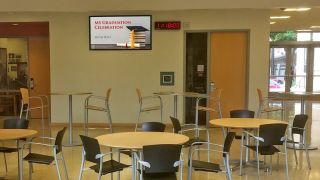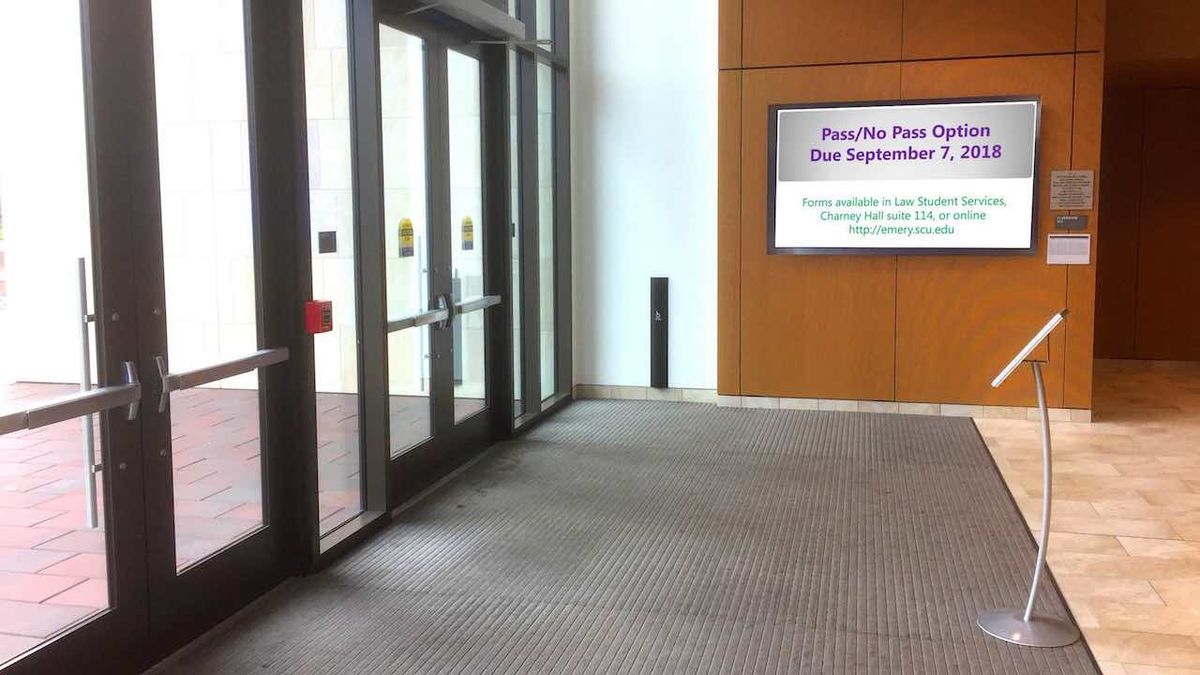As universities and higher education institutions seek to expand the horizons of their digital signage networks, many have discovered the campus-wide communications and media limitations of their first-generation systems. This was the case at Santa Clara University in Northern California, which upgraded to Navori’s QL digital signage engine before the Fall 2018 quarter. The upgrade has at once simplified operations and enabled new services and opportunities across the 80-screen network.
Navori QL is a cloud or on-premise solution—Santa Clara opted for the centralized cloud deployment—that offers a flexible, multi-seat architecture for campus-wide networks. That multi-seat flexibility was a key deciding factor for the 24 content managers contributing to the 80-screen network, which has a presence in almost every building on campus. The high-quality reproduction of 4K graphics and other visual content, along with general ease of use, competitive pricing, and rich data integration, further set Navori apart from other vendors competing for the project.
“Our previous system was out of date, and it couldn’t accommodate the more specialized initiatives we wanted to launch,” said Elwood Mills, manager of SCU digital signage, Santa Clara University. With responsibilities that include network maintenance, Mills grew increasingly frustrated with the previous system’s lack of reliability. “Connectivity issues with the servers continued to escalate, which often meant that random screens would remain blank for hours or days at a time.”
Mills often handles the editing and dissemination of content contributed from the 24 managers. While much of this content is distributed campus-wide, specialized slides are often created for certain departments, including the School of Engineering. Nicole Morales, director of digital media technologies for the School of Engineering, noted that Navori QL’s ease of use and richer data capabilities have made an enormous difference throughout the department.
“I have seven screens under my control across four buildings, and we do a lot of our own content creation across faculty and student organizations,” Morales said. “With our previous system, it would take up to 15 minutes for screens to refresh when new content was uploaded. Navori has eliminated the problems we were having with reliability in content delivery, which means the information we post about classes and events can go live with short notice. Navori also allows us to securely use outside URLs, and integrate live feeds from our different social media networks through the external Tagboard service. We’ve been able to drive a much higher degree of interaction with our social media feeds through digital signage.”

Ali Reimer, assistant director of marketing and communications for the Leavey School of Business, manages the digital screens that live within Lucas Hall. She noted that the screens have become a central communications platform to promote events and course information to business students and visitors, and promote faculty members and their research projects among other initiatives.
“We have about 15 screens spread throughout Lucas Hall, and Navori’s multi-user capability means we can focus exactly on the needs of our departments and centers and drive that strategy locally,” Reimer said. “Navori makes it very simple to create different playlists for different audiences throughout the day, which are timed to go live based on when those audiences are in the building. It provides a consistent, reliable, and visually impressive platform to market to both current and prospective students, and otherwise allows us to communicate the specific messages we aim to deliver.”
Reimer added that Navori QL has also improved visual quality across the network for both 4K and 1080p content. She has been exploring the many different template options for portrait and landscape displays in her department, and been gradually incorporating more tickers to develop a more well-rounded experience.
Moving forward, Mills expects to extend the network to new buildings currently being planned or that are already under construction. He also is working with Navori to integrate the campus emergency notification system with the digital signage network, using the Common Alerting Protocol (CAP). Once live, the integration will provide a digital format to disseminate emergency messages simultaneously over the Navori QL network and other communications systems around campus.
“Digital signage brings a lot of value to campus life, from general communications and marketing through to campus safety and security,” Mills said. “Navori has made life easier for everyone involved in the network, while also breathing new life into our content and messaging. We no longer have to rotate through three or four screens to manage content. The ease of use of QL is what really sells. Digital signage is no longer time-consuming.”










